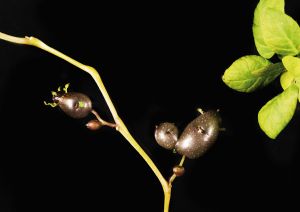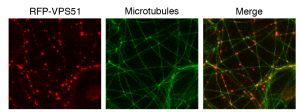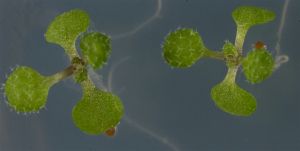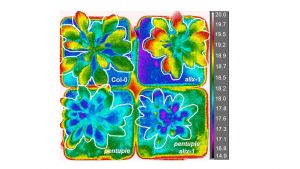- Si las condiciones ambientales son buenas, las plantas de patata utilizan los azucares en la parte aérea para crecer, mientras que para sobrevivir al invierno los acumulan en tubérculos bajo tierra en forma de almidón
- El gen BRANCHED1b, que regula varios procesos moleculares relacionados con periodos de inactividad vegetal, es también responsable de que los tubérculos se formen bajo tierra
Investigadores del Consejo Superior de Investigaciones Científicas identifican una nueva función del gen BRANCHED1b, que ha resultado ser esencial para la formación de tubérculos bajo tierra. El trabajo, que se publica ahora en Nature Plants muestra que mutaciones en este gen afectan a la capacidad de distinguir entre tallos aéreos y subterráneos (llamados estolones) en las plantas de patata. De esta manera en las plantas mutantes se produce una distribución errónea de los azucares y de las señales que controlan la formación de tubérculos y estas desarrollan tubérculos aéreos, expuestos a las inclemencias del tiempo y los animales.
El equipo del CSIC dirigido por Pilar Cubas, en colaboración con el de Salomé Prat, en el Centro Nacional de Biotecnología (CNB-CSIC) ha identificado que el gen llamado BRANCHED1b (BRC1b) es esencial para que los tubérculos se formen únicamente en la parte subterránea de la planta. Cubas explica sus resultados “utilizando como modelo plantas de patata silvestres y mutantes que no expresaban este gen, estudiamos la formación de tallos aéreos y subterráneos (llamados estolones) durante seis semanas. Así observamos que los mutantes producían más tallos aéreos, pero menos estolones que las plantas silvestres. Pero el cambio más llamativo se refería a la formación de tubérculos: los mutantes producían muchos menos tubérculos subterráneos y de menor tamaño, y además, empezaron a producir tubérculos aéreos.”
PLoS Pathog. 2022 Feb 18;18(2):e1010332.
AA Valli, R García López, M Ribaya, FJ Martínez, D García Gómez, B García, I Gonzalo, A Gonzalez de Prádena, F Pasin, I Montanuy, E Rodríguez-Gonzalo, JA García
Abstract
Cassava brown streak disease (CBSD), dubbed the "Ebola of plants", is a serious threat to food security in Africa caused by two viruses of the family Potyviridae: cassava brown streak virus (CBSV) and Ugandan (U)CBSV. Intriguingly, U/CBSV, along with another member of this family and one secoviridae, are the only known RNA viruses encoding a protein of the Maf/ham1-like family, a group of widespread pyrophosphatase of non-canonical nucleotides (ITPase) expressed by all living organisms. Despite the socio-economic impact of CDSD, the relevance and role of this atypical viral factor has not been yet established. Here, using an infectious cDNA clone and reverse genetics, we demonstrate that UCBSV requires the ITPase activity for infectivity in cassava, but not in the model plant Nicotiana benthamiana. HPLC-MS/MS experiments showed that, quite likely, this host-specific constraint is due to an unexpected high concentration of non-canonical nucleotides in cassava. Finally, protein analyses and experimental evolution of mutant viruses indicated that keeping a fraction of the yielded UCBSV ITPase covalently bound to the viral RNA-dependent RNA polymerase (RdRP) optimizes viral fitness, and this seems to be a feature shared by the other members of the Potyviridae family expressing Maf/ham1-like proteins. All in all, our work (i) reveals that the over-accumulation of non-canonical nucleotides in the host might have a key role in antiviral defense, and (ii) provides the first example of an RdRP-ITPase partnership, reinforcing the idea that RNA viruses are incredibly versatile at adaptation to different host setups.
doi: 10.1371/journal.ppat.1010332.
Proc Natl Acad Sci U S A. 2020 Apr 22. pii: 201919820.
Delgadillo MO, Ruano G, Zouhar J, Sauer M, Shen J, Lazarova A, Sanmartín M, Lai LTF, Deng C, Wang P, Hussey PJ, Sánchez-Serrano JJ, Jiang L, Rojo E.
Abstract
The factors and mechanisms involved in vacuolar transport in plants, and in particular those directing vesicles to their target endomembrane compartment, remain largely unknown. To identify components of the vacuolar trafficking machinery, we searched for Arabidopsis modified transport to the vacuole (mtv) mutants that abnormally secrete the synthetic vacuolar cargo VAC2. We report here on the identification of 17 mtv mutations, corresponding to mutant alleles of MTV2/VSR4, MTV3/PTEN2A MTV7/EREL1, MTV8/ARFC1, MTV9/PUF2, MTV10/VPS3, MTV11/VPS15, MTV12/GRV2, MTV14/GFS10, MTV15/BET11, MTV16/VPS51, MTV17/VPS54, and MTV18/VSR1 Eight of the MTV proteins localize at the interface between the trans-Golgi network (TGN) and the multivesicular bodies (MVBs), supporting that the trafficking step between these compartments is essential for segregating vacuolar proteins from those destined for secretion. Importantly, the GARP tethering complex subunits MTV16/VPS51 and MTV17/VPS54 were found at endoplasmic reticulum (ER)- and microtubule-associated compartments (EMACs). Moreover, MTV16/VPS51 interacts with the motor domain of kinesins, suggesting that, in addition to tethering vesicles, the GARP complex may regulate the motors that transport them. Our findings unveil a previously uncharacterized compartment of the plant vacuolar trafficking pathway and support a role for microtubules and kinesins in GARP-dependent transport of soluble vacuolar cargo in plants.
doi: 10.1073/pnas.1919820117
- La regulación de la señalización mediada por ácido jasmónico es clave para mantener el equilibrio entre crecimiento y defensa
- Las proteínas BPM regulan la degradación de los factores de transcripción que activan la respuesta inmune.
La supervivencia de las plantas en la naturaleza requiere su adaptación a diferentes tipos de estrés medioambiental. A diferencia de los animales, las plantas no tienen posibilidad de escapar cuando se enfrentan a una agresión externa como la mordedura de un insecto. Por este motivo, han desarrollado mecanismos de señalización interna y respuesta a través de hormonas como el ácido jasmónico. Sin embargo, la respuesta desencadenada por esta hormona frena el crecimiento de la planta para centrar los recursos en la defensa. Así, un exceso de acción de esta hormona puede afectar al desarrollo vegetal, por lo que su señalización debe estar regulada de una manera muy precisa en tiempo e intensidad.
Ahora, investigadores del Centro Nacional de Biotecnología (CNB) pertenecientes al Consejo Superior de Investigaciones Científicas (CSIC) en colaboración con las universidades de Estrasburgo y Navarra han identificado un nuevo mecanismo molecular que modula los pulsos de activación de la hormona. El trabajo, que ha sido publicado en la revista Proceedings of the National Academy of Sciences (PNAS), da respuesta a cómo se regula la activación de defensas hasta alcanzar un equilibrio entre crecimiento y respuesta a estrés.
Roberto Solano, researcher and current director of the Plant Molecular Genetics Department at the National Center for Biotechnology (CNB) appears in the list of the highly cited researchers in the field of animal and plant sciences published by Clarivate Analytics.
Dr. Solano is among the 120 Spanish scientists included this year, of which 24 researchers belong to the National Research Council (CSIC). This list identifies approximately 4000 researchers who have demonstrated significant influence in specific fields through publication of multiple highly cited papers during the last decade. This year, as a novelty, 2000 scientists with cross-field impact were identified and added to the classification.
Dr. Solano's research group is focused on studying the molecular mechanisms that allow plants to adapt to the environment. Their efforts have been directed to understand how jasmonate, a plant hormone, is involved in stress responses. His work have led to the identification of the jasmonate active form as well as a family of cue proteins for jasmonate signaling , both in Arabidopsis thaliana and Marchantia polymorpha. These results have been recently publishsed in high impact scientific jorunals as Current Biology, Plant Cell and Molecular Plant.
Front Plant Sci. 2019 Sep 17;10:1095. eCollection 2019.
Fonseca S, Rubio V.
Abstract
CULLIN4 (CUL4) RING ligase (CRL4) complexes contain a CUL4 scaffold protein, associated to RBX1 and to DDB1 proteins and have traditionally been associated to protein degradation events. Through DDB1, these complexes can associate with numerous DCAF proteins, which directly interact with specific targets promoting their ubiquitination and subsequent degradation by the proteasome. A characteristic feature of the majority of DCAF proteins that associate with DDB1 is the presence of the DWD motif. DWD-containing proteins sum up to 85 in the plant model species Arabidopsis. In the last decade, numerous Arabidopsis DWD proteins have been studied and their molecular functions uncovered. Independently of whether their association with CRL4 has been confirmed or not, DWD proteins are often found as components of additional multimeric protein complexes that play key roles in essential nuclear events. For most of them, the significance of their complex partnership is still unexplored. Here, we summarize recent findings involving both confirmed and putative CRL4-associated DCAF proteins in regulating nuclei architecture remodelling, DNA damage repair, histone post-translational modification, mRNA processing and export, and ribosome biogenesis, that definitely have an impact in gene expression and de novo protein synthesis. We hypothesized that, by maintaining accurate levels of regulatory proteins through targeted degradation and transcriptional control, CRL4 complexes help to surveil nuclear processes essential for plant development and survival.
doi: 10.3389/fpls.2019.01095
Front Plant Sci. 2019 Sep 5;10:1044. eCollection 2019.
Contreras R, Kallemi P, González-García MP, Lazarova A, Sánchez-Serrano JJ, Sanmartín M, Rojo E.
Abstract
The transition of stem cells from self-renewal into differentiation is tightly regulated to assure proper development of the organism. Arabidopsis MINIYO (IYO) and its mammalian orthologue RNA polymerase II associated protein 1 (RPAP1) are essential factors for initiating stem cell differentiation in plants and animals. Moreover, there is evidence suggesting that the translocation of IYO and RPAP1 from the cytosol into the nucleus functions as a molecular switch to initiate this cell fate transition. Identifying the determinants of IYO subcellular localization would allow testing if, indeed, nuclear IYO migration triggers cell differentiation and could provide tools to control this crucial developmental transition. Through transient and stable expression assays in Nicotiana benthamiana and Arabidopsis thaliana, we demonstrate that IYO contains two nuclear localization signals (NLSs), located at the N- and C-terminus of the protein, which mediate the interaction with the NLS-receptor IMPA4 and the import of the protein into the nucleus. Interestingly, IYO also interacts with GPN GTPases, which are involved in selective nuclear import of RNA polymerase II. This interaction is prevented when the G1 motif in GPN1 is mutated, suggesting that IYO binds specifically to the nucleotide-bound form of GPN1. In contrast, deleting the NLSs in IYO does not prevent the interaction with GPN1, but it interferes with import of GPN1 into the nucleus, indicating that IYO and GPN1 are co-transported as a complex that requires the IYO NLSs for import. This work unveils key domains and factors involved in IYO nuclear import, which may prove instrumental to determine how IYO and RPAP1 control stem cell differentiation.
doi: 10.3389/fpls.2019.01044.
Plant Cell. 2019 Aug 7. pii: tpc.00974.2018
Peñuelas M, Monte I, Schweizer F, Vallat A, Reymond P, García-Casado G, Franco-Zorrilla JM, Solano R.
Abstract
Jasmonoyl-isoleucine regulates plant immunity, growth and development in vascular plants by activating genome-wide transcriptional reprogramming. In Arabidopsis, this is largely orchestrated by MYC2 and related transcription factors (TFs). However, the TFs activating this pathway in basal plant lineages are currently unknown. We report the functional conservation of MYC-related TFs between the eudicot Arabidopsis thaliana and the liverwort Marchantia polymorpha, which belongs to an early diverging land-plant lineage. Phylogenetic analysis suggests that MYC function first appeared in charophycean algae, and therefore predates the evolutionary appearance of any other jasmonate pathway component. Marchantia possesses two functionally interchangeable MYC genes, one in females and one in males. Similar to AtMYC2, MpMYCs showed nuclear localization, interaction with JAZ-repressors, and regulation by light. Phenotypic and molecular characterization of loss- or gain-of-function mutants demonstrated that MpMYCs are necessary and sufficient for the activation of the pathway in Marchantia, but unlike their Arabidopsis orthologs, do not regulate fertility. Our results show that despite 450 million years of independent evolution, MYCs are functionally conserved between bryophytes and eudicots. Genetic conservation in an early diverging lineage suggests that MYC function existed in the common ancestor of land plants and evolved from a pre-existing MYC function in charophycean algae.
doi: 10.1105/tpc.18.00974
- El equipo de Vicente Rubio ha identificado un mecanismo por el cual las plantas regulan de manera precisa la respuesta a las variaciones en la disponibilidad del agua.
Los estomas son unos pequeños poros que se encuentran en las hojas y los tallos de las plantas, a través de los cuales se realiza el intercambio gaseoso. Sin embargo, también son la vía por la se pierde el agua a través de la transpiración. En condiciones de sequía, las plantas cierran los estomas mediante un proceso que está controlado por el ácido abscísico (ABA), una hormona vegetal que se sintetiza cuando la planta detecta la falta de agua.
En el artículo del Dr. Vicente Rubio, publicado en The Plant Cell, han identificado una factor de Arabidopsis, ALIX, una proteína de membrana que interacciona con los receptores de ABA y regula su tráfico y posterior degradación en la vacuola.
COOKIES POLICY
A cookie is a text file that is stored on your computer or mobile device via a web server and only that server will be able to retrieve or read the contents of the cookie and allow the Web site remember browser preferences and navigate efficiently. Cookies make the interaction between the user and the website faster and easier.
General information
This Website uses cookies. Cookies are small text files generated by the web pages you visit, which contain the session data that can be useful later in the website. In this way this Web remembers information about your visit, which can facilitate your next visit and make the website more useful.
How do cookies?
Cookies can only store text, usually always anonymous and encrypted. No personal information is ever stored in a cookie, or can be associated with identified or identifiable person.
The data allow this website to keep your information between the pages, and also to discuss how to interact with the website. Cookies are safe because they can only store information that is put there by the browser, which is information the user entered in the browser or included in the page request. You can not run the code and can not be used to access your computer. If a website encrypts cookie data, only the website can read the information.
What types of cookies used?
The cookies used by this website can be distinguished by the following criteria:
1. Types of cookies as the entity that manages:
Depending on who the entity operating the computer or domain where cookies are sent and treat the data obtained, we can distinguish:
- Own cookies: are those that are sent to the user's terminal equipment from a computer or domain managed by the editor itself and from which provides the service requested by the user.
- Third party cookies: these are those that are sent to the user's terminal equipment from a machine or domain that is not managed by the publisher, but by another entity data is obtained through cookies.
In the event that the cookies are installed from a computer or domain managed by the editor itself but the information collected by these is managed by a third party can not be considered as party cookies.
2. Types of cookies as the length of time that remain active:
Depending on the length of time that remain active in the terminal equipment can be distinguished:
- Session cookies: cookies are a type designed to collect and store data while the user accesses a web page. Are usually used to store information that only worth preserving for the service requested by the user at any one time (eg a list of products purchased).
- Persistent cookies: cookies are a type of data which are stored in the terminal and can be accessed and treated for a period defined by the head of the cookie, and can range from a few minutes to several years.
3. Cookies types according to their purpose:
Depending on the purpose for which the data are processed through cookies, we can distinguish between:
- Technical cookies: these are those that allow the user to navigate through a web page or application platform and the use of different options or services it exist as, for example, control traffic and data communication, identify the session, access to restricted access parts, remember the elements of an order, make the buying process an order, make an application for registration or participation in an event, use security features while browsing store content for dissemination videos or sound or share content via social networks.
- Customization cookies: these are those that allow the user to access the service with some general characteristics based on a predefined set of criteria in the user terminal would eg language, the type of browser through which you access the service, the locale from which you access the service, etc.
- Analysis cookies: they are those that allow the responsible for them, monitoring and analyzing the behavior of users of the web sites that are linked. The information gathered through such cookies are used in measuring the activity of web sites, application or platform and for the profiling of user navigation of such sites, applications and platforms, in order to make improvements function data analysis how users use the service.
Management tool cookies
This Website uses Google Analytics.
Google Analytics is a free tool from Google that primarily allows website owners know how users interact with your website. Also, enable cookies in the domain of the site in which you are and uses a set of cookies called "__utma" and "__utmz" to collect information anonymously and reporting of website trends without identifying individual users..
For statistics of use of this website use cookies in order to know the level of recurrence of our visitors and more interesting content. This way we can concentrate our efforts on improving the most visited areas and make the user more easily find what they are looking for. On this site you can use the information from your visit for statistical evaluations and calculations anonymous data and to ensure the continuity of service or to make improvements to their websites. For more details, see the link below privacy policy [http://www.google.com/intl/en/policies/privacy/]
How to manage cookies on your computer: disabling and deleting cookies
All Internet browsers allow you to limit the behavior of a cookie or disable cookies within settings or browser settings. The steps for doing so are different for each browser, you can find instructions in the help menu of your browser.
If you decline the use of cookies, since it is possible thanks to the preferences menu of your browser or settings, reject, this website will continue to function properly without the use of the same.
Can you allow, block or delete cookies installed on your computer by setting your browser options installed on your computer:
- For more information about Internet Explorer click here.
- For more information on Chrome click here.
- For more information about Safari click here.
- For more information about Firefox click here.
Through your browser, you can also view the cookies that are on your computer, and delete them as you see fit. Cookies are text files, you can open and read the contents. The data within them is almost always encrypted with a numeric key corresponding to an Internet session so often has no meaning beyond the website who wrote it.
Informed consent
The use of this website on the other hand, implies that you paid your specific consent to the use of cookies, on the terms and conditions provided in this Cookies Policy, without prejudice to the measures of deactivation and removal of cookies that you can take, and mentioned in the previous section.










